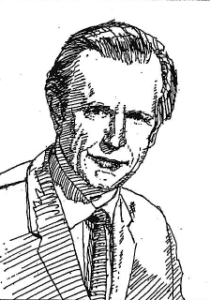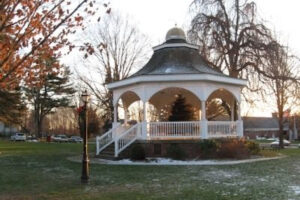 Barton L. Weller was born on February 17, 1916 in Seoul, Korea, to Methodist missionary parents. His father, Orville A. Weller, was an electrical engineering graduate of Ohio State University, who had been a power company executive before turning to missionary work.
Barton L. Weller was born on February 17, 1916 in Seoul, Korea, to Methodist missionary parents. His father, Orville A. Weller, was an electrical engineering graduate of Ohio State University, who had been a power company executive before turning to missionary work.
Bart was educated in Denver, Colorado, and in 1938 he obtained a B.S. in Physics from the University of Colorado followed by a Masters in Electrical Engineering from Massachusetts Institute of Technology. As a Research Assistant at the University of Colorado, he produced systems that generated an understanding of the then only known nuclear particles, cosmic rays. Later, as a Teaching Fellow at MIT, he wrote his Master’s thesis about flame barriers to stop anesthetic explosions in hospital operating rooms.
He began his industrial career as an electrical engineer for The General Electric Company. However, the war effort turned his talents to nuclear research as part of the program to develop an atomic bomb, known as The Manhattan Project. Following the war, he joined the Remington Arms division of DuPont in 1945. There, he worked on various new project studies, one of which was a project researching a mica substitute. At DuPont, he urged the commercial development of a technique for using porcelain and powdered silver to make capacitors (a device to store energy in an electronic circuit). When DuPont chose not to pursue this project, Bart left DuPont and went to work in his basement in Stepney, Connecticut, where he received third-degree burns from an explosion while developing the porcelain capacitor.
Unable to obtain a government development contract for his research, Bart raised $21,000 from friends and neighbors and formed Vitramon, Incorporated on November 8, 1948. As Bart’s development work turned into production of high reliability capacitors, Vitramon grew into a factory in Monroe, then to Route 111 in Trumbull. In 1960, when the ceramic capacitor was introduced, an additional facility was built on Route 25 in Monroe, Connecticut. At that time, sales volume approached $5 million, and Vitramon employed 500 people. Vitramon products were used in the Space Program, the Explorer, Vanguard, Telstar Communication Satellite, Titan lllC Launch Vehicle, Sikorsky CH53A Helicopter, Syncom Communication Satellite, Gemini, Surveyor, Ranger Space Vehicles, and Minute Man Missile Re-Entry Vehicles.
As industrial demand grew for Vitramon capacitors, Bart opened additional factories in England, Germany, France and Brazil utilizing the identical proprietary manufacturing process he developed in Connecticut. In 1987, Bart sold Vitramon to Thomas and Betts Incorporated, which in turn sold it in 1994 to its current owners, Vishay Intertechnology. With the infusion
of capital from these large conglomerates, over the years, Vitramon transformed this proprietary technology into the production of billions of units per year from factories in Roanoke, Virginia, and Migdal, Israel. At its peak, Vitramon manufactured and sold 11 billion capacitors per year, generating over $230 million in revenue while employing over 2,000 people worldwide. Bart’s approach to labor relations was viewed as a major and positive factor for the growth of Vitramon. His continued effort to promote equality between management and labor, an appreciation for an employee’s individual contribution and effort, and management’s continued presence among the employees, fostered and maintained a commonality spirit.
Bart also demonstrated a desire to share what he believed to be the fundamental elements of success with the young people of the Towns of Easton, Monroe, Newtown, Shelton, Trumbull and Redding, Connecticut. To that end, he created and funded The Vitramon Foundation in 1962 which later became The Weller Foundation, Incorporated in 1987. Bart believed that creative and curious minds required development through formal education and training. He also was convinced that financial obstacles frequently prevented otherwise ambitious young people from obtaining the fonual education required to succeed. He, therefore, chartered his Foundation to support these young, creative, and ambitious students by offering scholarships to high school seniors planning to attend institutions of higher learning. He never doubted that this kind of support would at some point benefit the communities from which they came and the country in general by providing educated leaders in a variety of fields. Today, The Weller Foundation, Incorporated carries out Bart’s wishes by offering numerous scholarship programs to students from the six-targeted towns and three major community educational programs.
The Foundation also has contributed to other community organizations and projects including the expansion of The Discovery Museum in Bridgeport, creation of Radio Station WMNR in Monroe, sponsorship of the Junior Achievement Economic Programs in five area high schools, and supported the purchase of library books in elementary, middle, and high schools in the Towns of Monroe, Trumbull, Easton, Newtown, and Shelton.
Bart was a member of the Electronics Industries Association, past Director of the E.I.A. Parts Division, and past Chairman of Fixed Ceramic, Glass & Vitreous Capacitor Section. He held fourteen patents for
 electronic components and two for the Weller World Watch, which displays time simultaneously in all international time zones. He was a member of the Board of Directors of Junior Achievement of Western Connecticut for 25 years and was inducted into the Free Enterprise Hall of Fame in 1977. Additionally, in 1981, he was a recipient of the National Management Association’s Silver Knight Award for executive leadership and contributions to the free enterprise system. As a member of the Board of Directors of the Barnum Festival, Bart served as the 1983 Ringmaster. Always concerned with the plight of refugees and immigrants, he was a long-term sponsor and Director of the International Institute of Connecticut. Bart was enjoying his self-imposed retirement by maintaining his interest in marketing his world watch and clock and flying his new airplane to Nova Scotia, where he was building his retirement home. Before he could realize the fulfillment of these, and other, dreams, he unexpectedly passed away on May 25, 1990. To honor Bart’s memory, a gazebo was constructed on the Monroe Town Green and dedicated on May 25, 1991.
electronic components and two for the Weller World Watch, which displays time simultaneously in all international time zones. He was a member of the Board of Directors of Junior Achievement of Western Connecticut for 25 years and was inducted into the Free Enterprise Hall of Fame in 1977. Additionally, in 1981, he was a recipient of the National Management Association’s Silver Knight Award for executive leadership and contributions to the free enterprise system. As a member of the Board of Directors of the Barnum Festival, Bart served as the 1983 Ringmaster. Always concerned with the plight of refugees and immigrants, he was a long-term sponsor and Director of the International Institute of Connecticut. Bart was enjoying his self-imposed retirement by maintaining his interest in marketing his world watch and clock and flying his new airplane to Nova Scotia, where he was building his retirement home. Before he could realize the fulfillment of these, and other, dreams, he unexpectedly passed away on May 25, 1990. To honor Bart’s memory, a gazebo was constructed on the Monroe Town Green and dedicated on May 25, 1991.
Bart’s Scientific Legacy is the unique capacitor manufacturing process; his Entrepreneurial Legacy is the economic success of the application of those capacitors; and his Philanthropic Legacy is the good work of The Weller Foundation.

